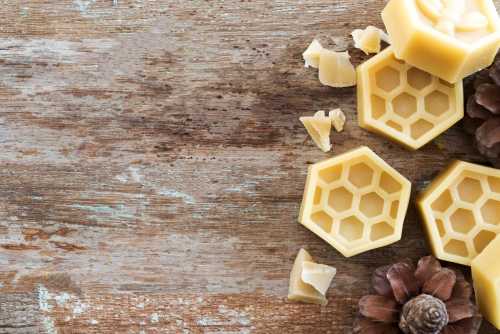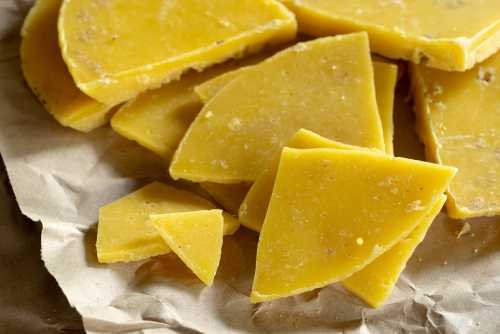How Do Bees Make Beeswax
And Why Do They Make It?
Beeswax has been found in Egyptian tombs dating from around 3,400 BC. Thus we can deduce that humans have been harvesting and finding uses for beeswax for a long time!
Nowadays, beeswax is primarily used for making candles and furniture polish, but also appears in beauty products such as lip balm and hand cream.
So how do bees make wax, and why? How is it harvested and do other bees make wax?
We’ll take a look at these questions, but first:
6 Interesting Facts About Beeswax

1. Bees make wax - but note that 'beeswax' is written as one word
2. The word 'wax' is derived from the Old English word 'weax', and this term was only applied to the wax of the European honey bee, Apis mellifera.
3. Just like honey, beeswax was used in ancient cultures, including in medicine. For example, it was recorded on the Ebers Papyrus of ancient Egypt (1550 B.C.) that beeswax was used in ointments and creams for burns and wounds and even joint pain. Beeswax was also discovered in a 9th century Viking ship found at Oseberg.
4. Beeswax and paraffin wax have different properties.
5. During the construction of wax comb, honey bees create a lace-type mesh. They do this by linking together to form chains, literally by grasping onto each other by their feet. This is called 'festooning'.
6. Beeswax was once a popular a painting medium, and is sometimes used today. See my page about 'encaustic art'.
How do honey bees make wax (Beeswax)?
Most of the wax is produced by young female worker bees and secreted from the wax glands on the underside of the abdomen when the workers are between 12 and 18 days old.
After young bees have secreted liquid wax from their abdomens, it solidifies (due to air contact) into small scale-like shapes that other worker bees then gather, and model with their ' 'mandibles (jaws)' to build the honeycombs.
Below is a short video from a study of a honey bee making wax cells in a hive. Watch carefully as she expels a small wax scale from under her abdomen!
Why do honey bees make wax and how do they use it?
 Honey bee larva in a cell - the walls of the cell are made from wax.
Honey bee larva in a cell - the walls of the cell are made from wax.Wax is used by honey bees to construct the individual, hexagonal wax cells where eggs are laid for rearing young bees, and honey is stored for winter.
Wax is also used by bees at the end of the process of honey making to ‘cap’ the cells. This means that a layer of wax is added over the honeycomb, so that the honey may be stored ready for when the bees need it during the winter. To read more about this, see How Do Bees Make Honey?
When is beeswax made by the colony?
Most of the wax is made during the active growth phase of the colony, and typically between the months of April and June.
In particular, wax and comb production and construction in the bee colony are determined by the following:
Nectar flow:
As bees bring greater quantities of nectar into the nest or hive, then they will need somewhere to store it. This results in more comb building, and a need for more wax. Nectar flow also stimulates the wax producing glands of worker bees.
Brood rearing (egg laying):
In a productive colony with an active egg-laying queen, more wax must be created by the workers for rearing young bees.
The presence of a queen:
Combs are only built in colonies that have a queen.
Temperature:
Conditions need to be sufficiently warm for bees to make and work the wax.
Also, as temperatures begin to rise and colonies become more active in foraging, rearing young and so on.
What does beeswax contain?
There is some variance depending on honey bee species, but the main compound families found in beeswax are:
alkanes, alkenes, free fatty acids, monoesters, diesters and hydroxymonoesters.
Fatty alcohols and hydroxydiesters are minor constituents.
How is beeswax harvested?
Beeswax is harvested and rendered by beekeepers.
Whilst harvesting the honey from the beehive, they remove the layers of wax the honey bees have deposited over the honeycomb cells during the capping process. For this, beekeepers use a special capping knife.
The beekeeper will then process the beeswax to remove impurities, and then furnish it into other items, such as balms or candles.

Can you eat beeswax?
Natural beeswax is edible. You may sometimes see honey for sale complete with chunks of wax honeycomb inside the jar. The honeycomb is edible, along with the honey.
Obviously you should never eat other processed products made with beeswax such as furniture polish.
 Chunk honey includes pieces of honeycomb.
Chunk honey includes pieces of honeycomb.Do bumble bees make wax?
Yes, bumble bees also make wax, but on a very small scale in comparison with honey bees.
Instead of constructing sophisticated honeycombs, bumble bees use wax to make nectar pots, and cover eggs.
Again, it is secreted from the underside of the abdomen. See Bumble bee Lifecycle for more information.
Resources
- Bogdanov, Stefan. (2016). Beeswax: Production, Properties, Composition, Control. Bee Product Science.
- A. P. Tulloch (1980) Beeswax—Composition and Analysis, Bee World, 61:2, 47-62, DOI: 10.1080/0005772X.1980.11097776
- Filippo Fratini, Giovanni Cilia, Barbara Turchi, Antonio Felicioli, Beeswax: A mini review of its antimicrobial activity and its application in medicine, Asian Pacific Journal of Tropical Medicine, Volume 9, Issue 9, 2016, Pages 839-843, ISSN 1995-7645.
- Siefert P, Buling N, Grünewald B (2021) Honey bee behaviours within the hive: Insights from long-term video analysis. PLoS ONE 16(3): e0247323. https://doi.org/10.1371/journal.pone.0247323


